We brushed on Google Hotel Ads in our post about technology and how it’s reshaping the travel industry. In this article, we’ll dig deeper into the different data feeds required in order to run a Google Hotel Ads campaign.
This article will focus on the purpose and benefits of Hotel Ads, as well as the feed requirements to get started.
Are you a hotelier, MSE or OTA? Do you want to increase your direct bookings and overall ROI? If so, then Google Hotel Ads and this article are for you.
Over the years, Google has slowly but surely made a name for itself in the travel industry. It all started back in 2011 when it launched the now retired Hotel Finder. Then, in 2015, came Google Hotel Price Ads, which are known today as Google Hotel Ads (GHA).
Why has Google put so much effort towards finding the perfect format for hoteliers and OTA’s?
It’s simple: As the world’s largest search engine, it knows exactly who is searching for what and how many searches are being made for what. So, when Google saw that it’s search engine was being used largely for travel-related search queries, it wanted to simplify the travel planning process for its users. Thus began Google's journey into the travel industry.
Now, with the introduction of Hotel Ads, hoteliers and OTA’s across the globe can benefit from using the world’s leading search engine as a strategic and powerful marketing tool!
What exactly are Google Hotel Ads, what are the benefits, and how can you get started? Read on to learn all of this and more!
What are Google Hotel Ads?
Google Hotel Ads enable you to showcase your hotels on Google, across desktops, tablets, and mobile devices. Hotel Ads are fueled by your hotel inventory feed. By providing Google with up-to-date and complete information about the pricing, availability and room types, it can surface relevant hotel ads to future travelers who are actively searching for accommodation either on Google Search or Google Maps.
Hotel Ads take into account the entire customer journey, meaning each stage of the trip-planning process. Google refers to these stages as “micro-moments.” These moments vary from the first thought of taking a holiday (i.e. honeymoon destinations), all the way down to planning activities during the trip (i.e. Navy Pier Chicago). Hotel Ads essentially get your property seen at the right time, by the right people, no matter how or where they are searching.
Here is an example path of how Google Hotel Ads appear to a user:
- The user performs a generic search for "hotel in New York" and views a few hotel options directly within the SERP before clicking to view more hotels (see below).
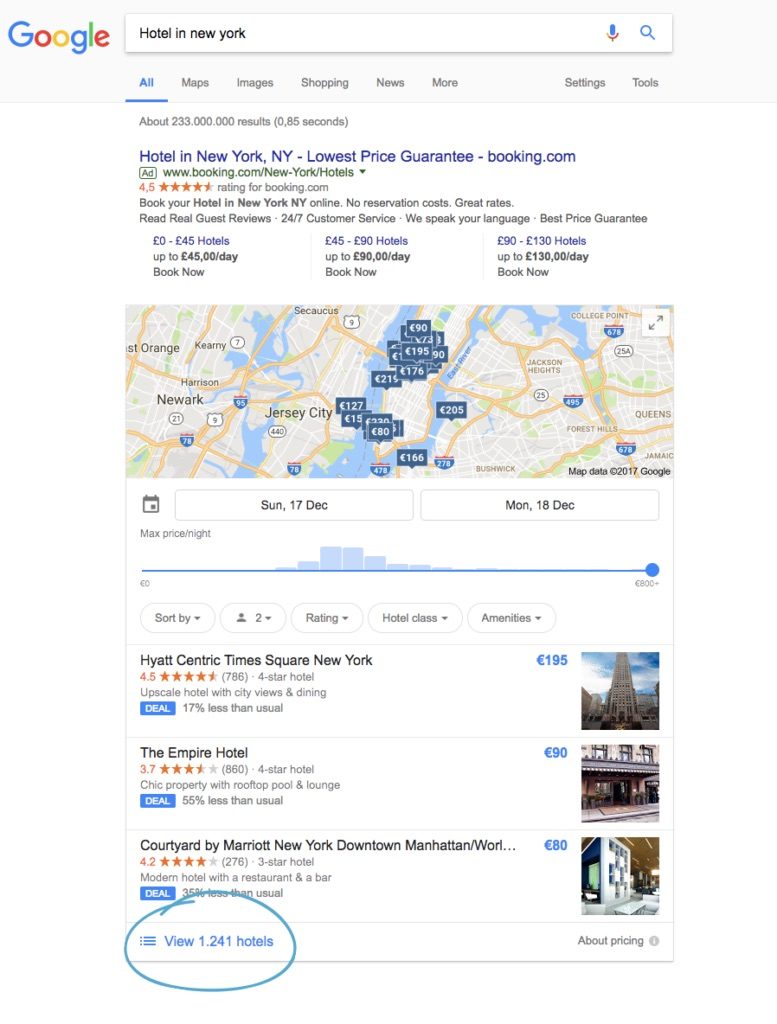
- Once a user clicks the link to view more hotels, they are taken to page showing many more search results. Here, they can filter based on their needs (using the options bar directly below the search bar). Once they click on a hotel on the left (left circle), they are able to see more information about that specific hotel and Google Hotel Ads (right circle).
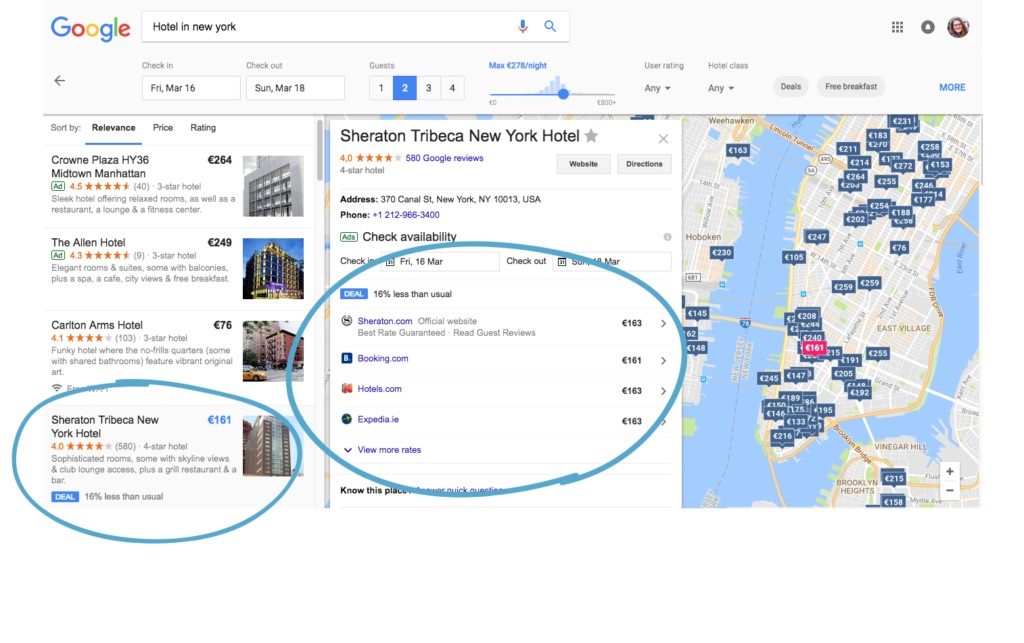
The Google Hotel Ads format generally sits higher in the engagement funnel. This means that users who aren’t going to sites like Booking.com or Expedia are likely beginning their research on Google.com. Since Google will serve them the first results, it technically acts as a “first touch OTA.”
How hoteliers can benefit from Google Hotel Ads
Once you’ve completed the initial setup and committed yourself to updating your high-quality feeds regularly (in some cases multiple times a day) you are well on your way to reaping major benefits, including a boost in ROI and direct bookings. As Google says, “you’re going to need a bigger welcome mat. Hilton Worldwide, for instance, saw a 12% increase in ROI with Google Hotel ads compared to standard search ads.
Now let’s dive deeper into how the format will boost performance:
Increase in direct traffic
According to Google, 60% of leisure travelers and 55% of business travelers use its search engine to plan their trips. That’s a lot of traffic, right? Once a user clicks on your Hotel Ad, they’re taken directly to your hotel’s booking page. Considering that Hotel Ads are cross-device compatible and that they appear for both generic and specific searches significantly increases the stream if direct traffic from relevant, purchase-ready travelers to your website.
### “Hotel Ads is essentially an additional source of direct traffic and bookings for your hotel.” - Google
Own the traveler data & relationship with your guests
Due to the increased chance of direct traffic and thus bookings, there is no middleman between you and your guests. This means that you will be able to get useful analytics and insights from their trip-planning process. These will help you to understand and optimize the research process and experience for future guests.
An added benefit is that you have the opportunity to nurture the relationship long after your guests have checked out. Once you have their contact details from a direct booking you could, for example, send across a holiday newsletter or special offers. This can increase customer delight by allowing you to personalize and control your own brand experience.
Increase in revenue
By the time a user clicks on your Hotel Ad and is redirected to your site, they have most likely already filtered according to specific details like price range, availability, amenities, location, rating, etc.). This means that they are a qualified, warm, and ready-to-book lead, all before they even get to your booking page. Need proof?
- Premier Inn has seen a 40% growth in new customer bookings since using Hotel ads instead of traditional search ads
- La Quinta doubled their conversion rate with mobile Hotel Ads
What does Book on Google have to do with Hotel Ads?
Book on Google is an optional feature of Google Hotel Ads. By enabling the feature, you give users the option to book directly within Google’s interface. This means the complete transaction, including payment, would take place through Google. Although it may decrease the traffic coming to your website, it could increase your mobile conversions, as these users are more likely to book if there is no redirect.
Read more about Book on Google here.
Requirements for Google Hotel Ads
Hotel Ads require not just one, but several high-quality information sources, or feeds:
- __Hotel List Feed__
- __Price & Availability Feed__
- __Point of Sale Feed__
Let’s take a closer look at each.
Hotel List Feed
This information source provides a comprehensive list of all of your properties, including information like address, ratings and contact information. Google recommends including all of your properties, even if you are not going to advertise certain hotels. Here is an overview of the attributes that make up a Hotel List Feed:
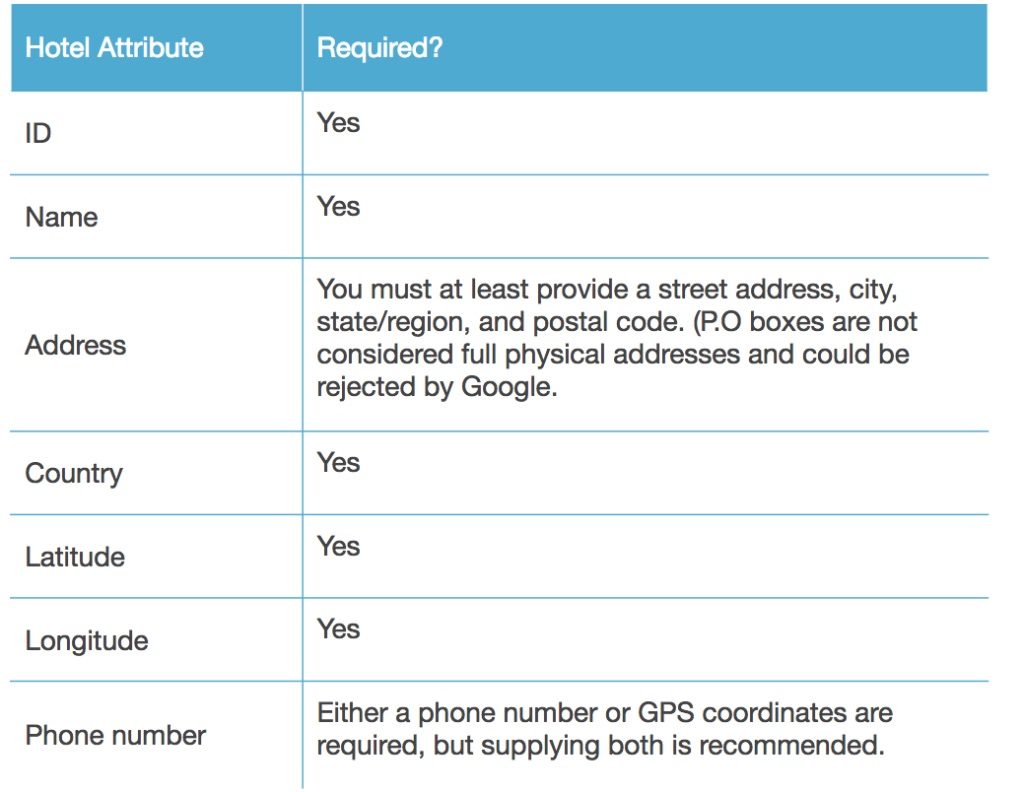
Your Hotel List Feed can be integrated to Google through an FTP or HTTP server. Keep in mind that if your data has any missing or inaccurate information, it may not be matched correctly with Google Places. In order to add or update any data, you can use the Google Places API.
Price & Availability Feed
This file should include all hotel room rates and availabilities. As these elements are almost constantly changing, this feed should be updated regularly to ensure that users are seeing accurate hotel information. Google recommends updating this feed multiple times each day to ensure the information displayed to travelers is correct. Here are the steps for creating a Price & Availability Feed:
- __Create transaction messages__: These are basically your way of responding automatically to Google’s queries and keeping your hotel data updated. For example, if Google thinks a piece of your data is not up-to-date, it will send a query, and your transaction messages are what keeps the prices available at all times. With these messages, you can also define room bundles, hotel prices, and inventory. As far as delivery type, you have two options: __Pull__ (send a message as a response to Google’s query) or __Pull with Hints__ (send a message after responding to a HintRequest and a query.) A HintRequest is essentially Google's way of asking you what has changed since the last update they received. It is recommended to work with a technical account manager if you select the Pull with Hints delivery mode.
- __Connect and test your price feeds__: Use Google’s Price Configuration tool for updating all of your price feeds. Note that some requirements in this step change based on your chosen delivery method in step one. You’ll then need to test your price feed enter your Price Indexing Configuration in order to begin indexing your prices.
QueryControl Messages will also come into play in this feed. These are essentially the boundaries that you tell Google to use when searching through your inventory. For example, you can define the number of days before check-in that will be surfaced and promoted by Google. These messages will be retrieved by Google once per day. In order for QueryControl messages to work, you’ll need to define four key elements:
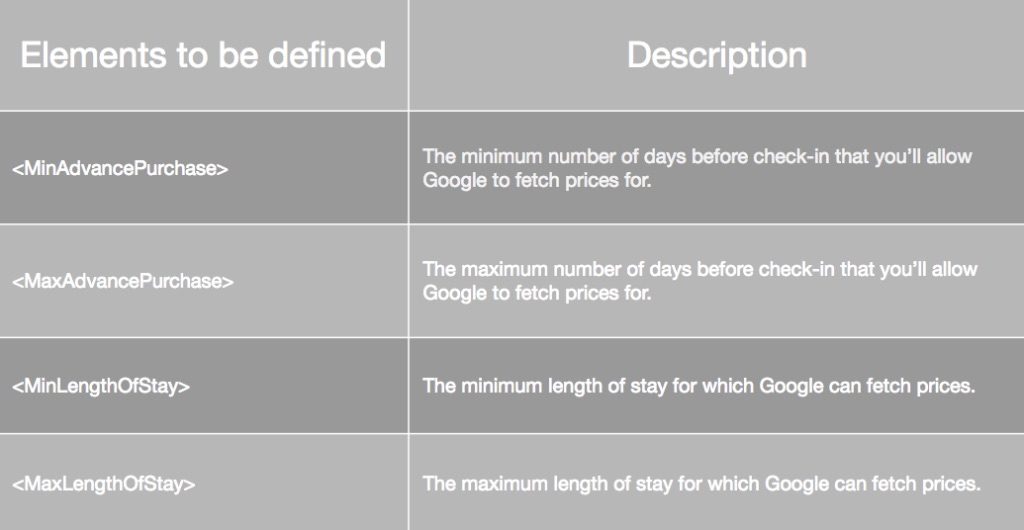
Once you’ve provided values for the above elements, Google will essentially be able to know exactly what information it can and can’t surface based on a specific search query.
Here is an example, provided by Google, of a complete QueryControl message that defines default pricing settings:
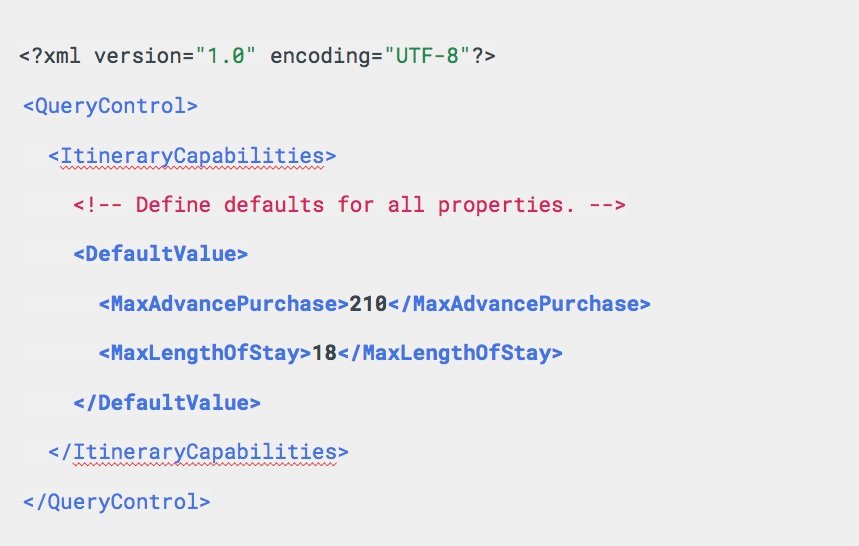
Point of Sale Feed
Also known as the POS Feed, this should contain information on where you want users to go once they click on your Hotel Ad. The redirect should take into account the user’s country, currency, device, and language, and should lead to a unique URL. Google recommends that your POS feed contains all possible combinations in order to achieve the best user experience and the number of impressions.
Keep in mind this is only a brief outline of what is required to run Google Hotel Ads.
Seem like a lot to do on your own? Have no fear, with Productsup, enriching and maintaining your Hotel List, Price & Availability, and POS Feeds is a piece of cake!
Productsup and Google Hotel Ads
So, you’re interested in running a Google Hotel Ads campaign, but you’re not sure where to start?
No Problem! Productsup is an authorized Hotel Ads Integration Partner! With our software, the structuring, optimizing, and exporting of both the Hotel List Feed and the Price Feed is easy and breezy (just like the balcony of that ocean-view suite)!
Need a Hotel List Feed? Why not start with the perfectly structured Hotel List Feed export template included in our software? After that, use our automated data-mapping tool to visually tailor and enhance your feed to Google’s requirements. Say goodbye to Excel! Once your feed has been perfectly optimized, you can quickly ship it off to Google!
Then you’ll need to create your Rooms and Availabilities Feed, which is just as simple. The Productsup software includes an export template and an API integration for this feed, too! What about the Hotel Metadata Feed? You guessed it! We'll also simplify the setup of your POS feed from scratch! Our software includes everything you need to create Hotel Ads.
Once you’re done putting the final touches on each feed, Productsup’s world-class integration team will create an API endpoint for Google.Just like that, you are good to go!

![[BlogPost][WP Import][SEO] The benefits and requirements of Google Hotel Ads](http://images.ctfassets.net/q17uls4wkkdz/5qbJXV6itDqTZKJoxU0Id9/50adcd17092c18e6acd8edf86915e93b/gha_facebook_600x315.png?w=1200&h=675&fit=FILL)